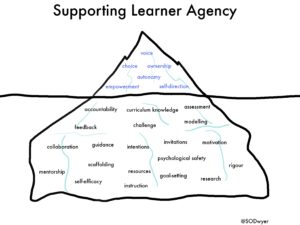
Shannon O’Dwyer is the Deputy Head – Academics at The King’s School (Preparatory School), an IB World School in Sydney, Australia
This article explores the complexities of learner agency. It discusses some important pedagogical practices that support self-directed, mastery-driven inquiry.
Learner agency is a key feature of the Enhanced PYP. As a community of educators, many of us are still working to create environments that support student agency. Recently, I’ve been imagining leaner agency, as the tip of an educational iceberg – that is, the visible evidence of empowered learning – but not the whole picture of what facilitates autonomous, mastery-driven learning.
It’s complex!
When my classroom starts buzzing with rich, student-led inquiry, I know that learner agency is high. I’m also aware that many other things are also going right. Provocations have sparked curiosity, invitations (cognitive and interpersonal) have been accepted, collaboration has been fruitful, and teacher guidance has been “goldilocked” (pitched at a just-right level to keep students striving for understanding).
Honestly, learner agency is not visible all day, every day. And it’s not the children, with strong opinions and giant questions, who lack motivation! I’m the reason that learner agency is not always unleashed. In my well-intentioned lessons, I miss their divergent comments, I offer a provocative question but rush their thinking time, or I give a factual answer when we should really marinate in confusion. Creating a high agency environment is a complex quest.
False Dichotomies
But complexity is good. Creating truly empowering classrooms should be challenging and even elusive at times. It’s complexity that protects us from the trap of false dichotomies. For example:
- Student choice OR teacher direction?
- It’s often a negotiation between an empowered learner and an invested teacher that creates a partnership supportive of agency.
- Student voice OR teacher voice?
- It’s a constant, robust dialogue: a mix of questioning, explaining, critiquing, affirming, interjecting and listening that steadily helps learners to advocate for their needs and articulate emerging theories.
- Student-owned learning OR teacher-owned learning?
- It’s a mess of collaboratively constructed understandings, during which nobody remembers (or cares) who led whom to deeper, richer realisations about the world.
These dichotomies often spark debate. However, they are of little consequence to classroom educators, working with children who need responsive, personalised guidance.
And they are never present in the documentation provided by the IB. (See The Learner, from Principles into Practice. The language of “moving away from/moving towards” supports teacher agency in making complex pedagogical choices.)
So…what supports learner agency?
Underpinning high agency environments are a host of not very new, not very innovative…but very important…educational practices. Here a few:
curriculum knowledge – Agency occurs when teachers know the curriculum so well, they can say “yes” to student-led inquiries because they are confident in making curricular connections and guiding conceptual learning.
- For example, if I know that students need to understand “environmental adaptation (change)”, one student might investigate the biological defences of cephalods while others map the behavioural migrations of birds – wherever their curiosity takes them!
assessment – Teachers who continually collect and analyse information about what students know and how they learn, are well-equipped to provide just-right, just-in-time guidance to sustain student-led inquiry.
For example, if I know each learner’s current understanding of 2D space, I might invite one student to develop a mathematical proof
- for alternate angles, while another spends several days constructing and measuring angles in a phase exploratory play.
psychological safety – Students advocate for their own learning when they trust that their mistakes are valued and respected by their peers and teachers.
- For example, displaying mathematical working that contains errors or written drafts that have been abandoned communicates the message that errors are integral to learning. Developing communication protocols for posing conjectures, building on peers’ ideas, and disagreeing with each other helps to build habits of respectful collaboration.
feedback (and feedforward) – Students exercise agency when they know the next steps to take on their journey of personal growth.
- For example, when assessment data is shared with, and owned by, students, they can tell me what their goals are! They gradually become assessment capable learners who are co-designers of success criteria. One student will say, “I’m working on topic sentences in my paragraphs” while another says, “I’m working on replacing adverbs with more powerful verbs”.
challenge – Only when students are challenged beyond current levels of understanding, do they experience the frustration and dissonance needed to ask questions, test theories and start investigations of their own.
- For example, when students begin to ask “Is that always true?” or “Is that the only way?” or “Why did that happen?” or “I don’t agree with that”, I know that the learning experience is sufficiently challenging, confusing and engaging to be stretching their current schema, causing them to seek deeper understanding. If everyone’s nodding, they probably knew it already.
And many more! My iceberg is an attempt to capture the complexity of supporting learner agency.
When we witness agency in classrooms, it is truly thrilling. Students are alive with purpose, passion and confidence. We should perhaps remember that many unseen, but important, factors support autonomous learning.
Beneath the iceberg, lies some powerful pedagogy.
Shannon O’Dwyer is the Deputy Head – Academics at The King’s School (Preparatory School), an IB World School in Sydney, Australia. She enjoys the synergy of collaboration and the wisdom of teams. Shannon is inspired by great teachers and inquisitive children, every day. She loves to talk but usually retracts her first idea. Shannon tweets at @S_ODwyer and blogs at http://shannonodwyer.com.


No comments yet.